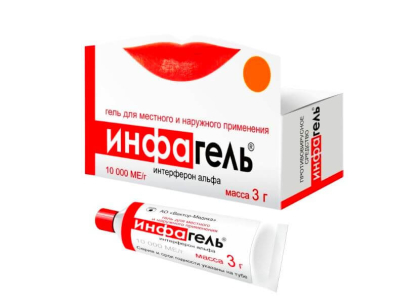Infagel (Interferon alfa) gel use 10 000ME
Description
Instructions for Infagel (Interferon alfa) gel for local and external use 10 000ME
English product name
Infagel
Release Form
Gel for local and outdoor use
2 g - aluminium tubes (1) - cardboard packs.
3 g - aluminium tubes (1) - cardboard packs.
5 g - aluminium tubes (1) - cardboard packs.
10 g - aluminium tubes (1) - cardboard packs.
2 g - bottles (1) - cardboard packs.
3 g - bottles (1) - cardboard packs.
5 g - bottles (1) - cardboard packs.
10 g - bottles (1) - cardboard packs.
- Nosology (ICD codes)
- A60
- Anogenital herpetic virus infection [herpes simplex]
- B00
- Infections caused by herpes simplex virus [herpes simplex]
- B00.2
- Herpetic gingivostomatitis and pharyngotonsilitis
- B02
- Shingles [herpes zoster]
- J06.9
- Acute upper respiratory tract infection unspecified
- J10
- Influenza caused by an identified seasonal influenza virus
- Z29.8
- Other specific preventive measures
Release Form
Gel
Composition
1 g gel contains: Active substance: human recombinant interferon alpha-2b 10 thousand ME;Auxiliary substances: aluminium (in the form of hydroxide) - 14 mg; polyvinyl alcohol - 75 mg; water purified up to 1 g.
Pharmacological effect
Infagel is interferon. It is a highly purified recombinant protein with a molecular mass of 19,300 daltons. It is derived from the Escherichia coli clone by hybridizing the plasmids of bacteria with the human leukocyte gene encoding interferon synthesis. Unlike interferon, alpha-2a has arginine at position 23. It has an antiviral effect, which is caused by interaction with specific membrane receptors and induction of RNA synthesis and, ultimately, proteins. The latter, in turn, prevent normal reproduction or release of the virus. It has immunomodulatory activity, which is associated with the activation of phagocytosis, stimulation of antibody and lymphocyn formation. It has an antiproliferative effect on tumor cells.
Testimony
- Treatment of herpetic lesions of the skin and mucous membranes: simple and encircling herpes relapsing facial herpes,
- genitals, gingivitis, herpetic stomatitis prevention of influenza and SARS in adults who have contact with flu and SARS
- patients.
- Contraindications
- Hypersensitivity, pregnancy, lactation period.
- Use in pregnancy and breastfeeding
- It is necessary to avoid getting Infagel gel into the eyes.
Method of use and doses
In the treatment of herpetic lesions, the gel is applied to the affected areas of the skin and mucous membranes twice daily at intervals of twelve hours and dried for 10-15 minutes to form a protective film. The duration of the treatment course is from three to five days, until the complete disappearance of the integrity of the skin and mucous membranes. In order to prevent influenza and ARVI during periods of increasing incidence, the preparation is applied to the mucous membrane of the nasal passages twice daily at intervals of twelve hours during the first and third weeks of the course, in the second week a break is made.
Features
- Expiration Date Always fresh
- Pharmacological group Antiviral
- Active substance Interferon alfa
- Weight 98 g
Categories: Antivirals
Infagel (Interferon alfa) gel use 10 000ME reviews (0)
Write a reviewBe the first to write a review of this product!



